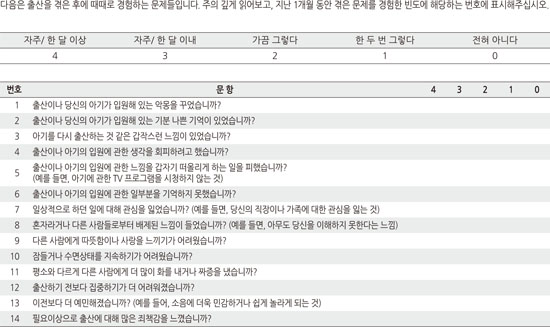Abstract
Purpose
The Perinatal Post-Traumatic Stress Disorder Questionnaire (PPQ) was designed to measure post-traumatic symptoms related to childbirth and symptoms during postnatal period. The purpose of this study was to develop a translated Korean version of the PPQ and to evaluate reliability and validity of the Korean PPQ.
Methods
Participants were 196 mothers at one to 18 months after giving childbirth and data were collected through e-mails. The PPQ was translated into Korean using translation guideline from World Health Organization. For this study Cronbach's alpha and split-half reliability were used to evaluate the reliability of the PPQ. Exploratory Factor Analysis (EFA), Confirmatory Factor Analysis (CFA), and known-group validity were conducted to examine construct validity. Correlations of the PPQ with Impact of Event Scale (IES), Beck Depression Inventory II (BDI-II), and Beck Anxiety Inventory (BAI) were used to test a criterion validity of the PPQ.
Results
Cronbach's alpha and Spearman-Brown split-half correlation coefficient were 0.91 and 0.77, respectively. EFA identified a 3-factor solution including arousal, avoidance, and intrusion factors and CFA revealed the strongest support for the 3-factor model. The correlations of the PPQ with IES, BDI-II, and BAI were .99, .60, and .72, respectively, pointing to criterion validity of a high level.
Figures and Tables
Figure. 1
Three-factor model of Korean mothers' perinatal PTSD with standardised parameter estimates and factor intercorrelations.

References
1. American Psychiatric Association. Diagnostic and statistical manual of mental disorders, third edition-revised. 3rd ed. Washington, DC: Author;1987.
2. American Psychiatric Association. Diagnostic and statistical manual of mental disorders, DSM-IV. 4th ed. Washington, DC: Author;1994.
3. Leeds L, Hargreavesa I. The psychological consequences of childbirth. J Reprod Infant Psychol. 2008; 26(2):108–122. DOI: 10.1080/02646830701688299.
4. Olde E, van der Hart O, Kleber R, van Son M. Posttraumatic stress following childbirth: A review. Clin Psychol Rev. 2006; 26(1):1–16. DOI: 10.1016/j.cpr.2005.07.002.
5. White T, Matthey S, Boyd K, Barnett B. Postnatal depression and post–traumatic stress after childbirth: Prevalence, course and cooccurrence. J Reprod Infant Psychol. 2006; 24(2):107–120. DOI: 10.1080/02646830600643874.
6. Alcorn KL, O'Donovan A, Patrick JC, Creedy D, Devilly GJ. A prospective longitudinal study of the prevalence of post-traumatic stress disorder resulting from childbirth events. Psychol Med. 2010; 40(11):1849–1859. DOI: 10.1017/s0033291709992224.
7. DeMier RL, Hynan MT, Harris HB, Manniello RL. Perinatal stressors as predictors of symptoms of posttraumatic stress in mothers of infants at high risk. J Perinatol. 1996; 16(4):276–280.
8. Ayers S, Pickering AD. Do women get posttraumatic stress disorder as a result of childbirth? A prospective study of incidence. Birth. 2001; 28(2):111–118.
9. Callahan JL, Hynan MT. Identifying mothers at risk for postnatal emotional distress: Further evidence for the validity of the perinatal posttraumatic stress disorder questionnaire. J Perinatol. 2002; 22(6):448–454. DOI: 10.1038/sj.jp.7210783.
10. Pizur-Barnekow K, Erickson S. Perinatal posttraumatic stress disorder: Implications for occupational therapy in early intervention practice. Occup Ther Ment Health. 2011; 27(2):126–139. DOI: 10.1080/0164212X.2011.566165.
11. Pierrehumbert B, Borghini A, Forcada-Guex M, Jaunin L, Müller-Nix C, Ansermet F. French validation of the "perinatal PTSD questionnaire" assessing parent's posttraumatic stress reactions following the birth of a high risk infant. Ann Med Psychol (Paris). 2004; 162(9):711–721. DOI: 10.1016/j.amp.2003.10.017.
12. Kim GS. Analysis structural equation modeling. Seoul: Hannarae Publishing Co.;2013.
13. Moon SB. Basic concepts and applications of structural equation modeling: With AMOS 19.0. Seoul: Hakjisa Corp;2009.
14. Callahan JL, Borja SE, Hynan MT. Modification of the perinatal PTSD questionnaire to enhance clinical utility. J Perinatol. 2006; 26(9):533–539. DOI: 10.1038/sj.jp.7211562.
15. Quinnell FA, Hynan MT. Convergent and discriminant validity of the perinatal PTSD questionnaire (PPQ): A preliminary study. J Trauma Stress. 1999; 12(1):193–199. DOI: 10.1023/a:1024714903950.
16. Horowitz M, Wilner N, Alvarez W. Impact of event scale: A measure of subjective stress. Psychosom Med. 1979; 41(3):209–218.
17. Weiss DS, Marmar CR. The impact of event scale—revised. In : Wilson JP, Keane TM, editors. Assessing psychological trauma and PTSD. New York, NY: Guilford;1997. p. 399–411.
18. Eun HJ, Kwon TW, Lee SM, Kim TH, Choi MR, Cho SJ. A study on reliability and validity of the Korean version of impact of event scale-revised. J Korean Neuropsychiatr Assoc. 2005; 44(3):303–310.
19. Beck AT, Steer RA, Brown GK. Manual for the Beck depression inventory-II. San Antonio, TX: Psychological Corporation;1996.
20. Kim MS, Lee IS, Lee CS. The validation study I of Korean BDI-II: In female university students sample. Korean J Clin Psychol. 2007; 26(4):997–1014.
21. Kwon SM. Differential roles of dysfunctional attitudes and automatic thoughts in depression: An integrated cognitive model of depression [dissertation]. Brisbane, AU: The University of Queensland;1993.
22. World Health Organization. Process of translation and adaptation of instruments [Internet]. Geneva, CH: Author;2015. cited 2015 March 13. http://www.who.int/substance_abuse/research_tools/translation/en/.
23. Kang H. A guide on the use of factor analysis in the assessment of construct validity. J Korean Acad Nurs. 2013; 43(5):587–594. DOI: 10.4040/jkan.2013.43.5.587.
24. American Psychiatric Association. Diagnostic and statistical manual of mental disorders, fifth edition (DSM-5). 5th ed. Washington, DC: Author;2013.
25. Harrington D. Confirmatory factor analysis. New York, NY: Oxford University Press;2009.
26. Hong S. The criteria for selecting appropriate fit indices in structural equation modeling and their rationales. Korean J Clin Psychol. 2000; 19(1):161–177.
27. DeVellis RF. Scale development: Theory and applications. 3rd ed. Thousand Oaks, CA: Sage Publications;2012.
28. Seong TJ. Validity and reliability. Seoul: Hakjisa Corp;2010.
29. Kessler RC, Sonnega A, Bromet E, Hughes M, Nelson CB. Posttraumatic stress disorder in the national comorbidity survey. Arch Gen Psychiatry. 1995; 52(12):1048–1060. DOI: 10.1001/archpsyc.1995.03950240066012.
30. Lee K, Shin S. Validity of instrument development research in Korean nursing research. J Korean Acad Nurs. 2013; 43(6):697–703. DOI: 10.4040/jkan.2013.43.6.697.




 PDF
PDF ePub
ePub Citation
Citation Print
Print







 XML Download
XML Download